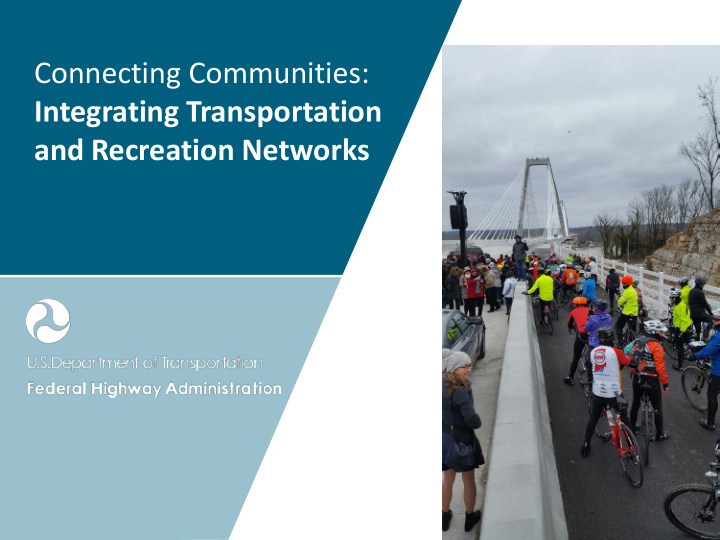



Connecting Communities: Integrating Transportation and Recreation Networks
USDOT Strategic Plan for FY 2018-2022 GOALS Safety Reduce Transportation-Related Fatalities and Serious Injuries Across • the Transportation System. Infrastructure Invest in Infrastructure to Ensure Mobility and Accessibility and to • Stimulate Economic Growth, Productivity, and Competitiveness for American Workers and Businesses. Innovation Lead in the Development and Deployment of Innovative Practices and • Technologies that Improve the Safety and Performance of the Nation's Transportation System. Accountability Serve the Nation with Reduced Regulatory Burden and Greater • Efficiency, Effectiveness, and Accountability. 2
Bicyclists 3 FHWA Achieving Multimodal Networks: Applying Design Flexibility and Reducing Conflicts
National Context FHWA Programs Support: • An integrated, safe, accessible, and convenient transportation system for all • Connected pedestrian and bicycle networks • Design flexibility • Economic development • Efficient project development • Equity, quality of life, and livability • Multimodal data • Sustainable transportation policies and practices 4
Available at www.fhwa.dot.gov/environment/bicycle_pedestrian
Connecting Communities: Integrating Transportation and Recreation • We can connect and integrate transportation and recreation infrastructure. • Trails: spines for transportation networks. • Transportation and Recreation isn’t either/or! 6
Bridges and Tunnels: Essential Links for Networks • Long life spans: Plan for future demand, use, and reuse. • Bridges connect communities. 7
Bridges and Tunnels: Essential Links for Networks • Reconnect communities. • Tunnels and underpasses. 8
Recreational trails used for transportation • Rail-trails and other shared use paths. • No Federal law or regulation requires pavement, (accessibility requires “firm and stable”). • No Federal law or regulation prohibits equestrian use. 9
Recent FHWA Pedestrian and Bicycle Resources See www.fhwa.dot.gov/environment/bicycle_pedestrian 10
Small Town and Rural Multimodal Networks • Bicycle and pedestrian design in a rural context. • Encourages innovation in development of safe and appealing networks for bicycling and walking. • Examples of peer communities and project implementation. 11
Connected Networks 12
Achieving Multimodal Networks: Applying Design Flexibility and Reducing Conflicts • Provide design flexibility, while reducing multimodal conflicts and achieving connected networks • Help practitioners address topics such as: – Intersection design – Road diets – Pedestrian crossing treatments – Transit and school access – Freight – Accessibility 13
14
15
16
Coming Soon ! Coming Soon ! Top Strategies for Accelerating Multimodal Infrastructure Delivery 17
Proven Safety Countermeasures safety.fhwa.dot.gov/provencountermeasures
Ongoing Research Projects FHWA has the following research projects underway: • Every Day Counts /Community Connections Initiative • Safe Transportation for Every Pedestrian (STEP) • MySidewalk mobile app • Rails-with-Trails Effective Practices • Top Strategies for Accelerating Multimodal Infrastructure Delivery • Bicycle and Pedestrian Case Studies on project streamlining 19
Integrating Transportation and Recreation: Resources Shared Use Path presentation: www.fhwa.dot.gov/environment/bicycle_pedestrian/guid ance/design_guidance/design_nonmotor/shared/ Recreational Trail presentation: www.fhwa.dot.gov/environment/bicycle_pedestrian/guid ance/design_guidance/design_nonmotor/recreation/ 20
Youth Corps and Workforce Development • DOT encourages States to have contracts and cooperative agreements with qualified Youth Service and Conservation Corps. • Corps work on recreational trails, pedestrian and bicycle projects, safe routes to school. • Corps provide workforce development training. • Agencies can sole source to qualified Corps. https://www.fhwa.dot.gov/environment/transportation_alternatives/ • guidance/youth_workforcedev.cfm 21
Useful FHWA Websites • USDOT Bicycle/Pedestrian Website • https://www.transportation.gov/bicycles-pedestrians • Pedestrian and Bicycle Information Center http://www.pedbikeinfo.org/ • • FHWA Office of Safety Website • https://safety.fhwa.dot.gov/ped_bike/ • FHWA Office of Planning Website • https://www.fhwa.dot.gov/environment/bicycle_pedestrian/ • FHWA Accessibility Website • https://www.fhwa.dot.gov/accessibility/ • FHWA Federal-aid Essentials for Local Public Agencies • https://www.fhwa.dot.gov/federal-aidessentials/index.cfm 22
FHWA Contacts Divisions: https://www.fhwa.dot.gov/about/field.cfm Local contacts: National contacts: Christopher Douwes Chandra Inglis-Smith Office of Planning, Environment, and Realty WV Division Planner Christopher.Douwes@dot.gov Chandra.Inglis-Smith@dot.gov Cathy Satterfield, P.E. & Gabriel Rousseau Office of Safety Shaneka Owens Cathy.Satterfield@dot.gov or WV Division Safety Engineer Gabe.Rousseau@dot.gov Shaneka.Owens@dot.gov Dave Kirschner Office of Operations (MUTCD) Matt Daly David.Kirschner@dot.gov WV Division Area Engineer Elizabeth Hilton Matt.Daly@dot.gov Office of Infrastructure Elizabeth.Hilton@dot.gov See www.fhwa.dot.gov/environment/bicycle_pedestrian/index.cfm 23
QUESTIONS ?
Recommend
More recommend